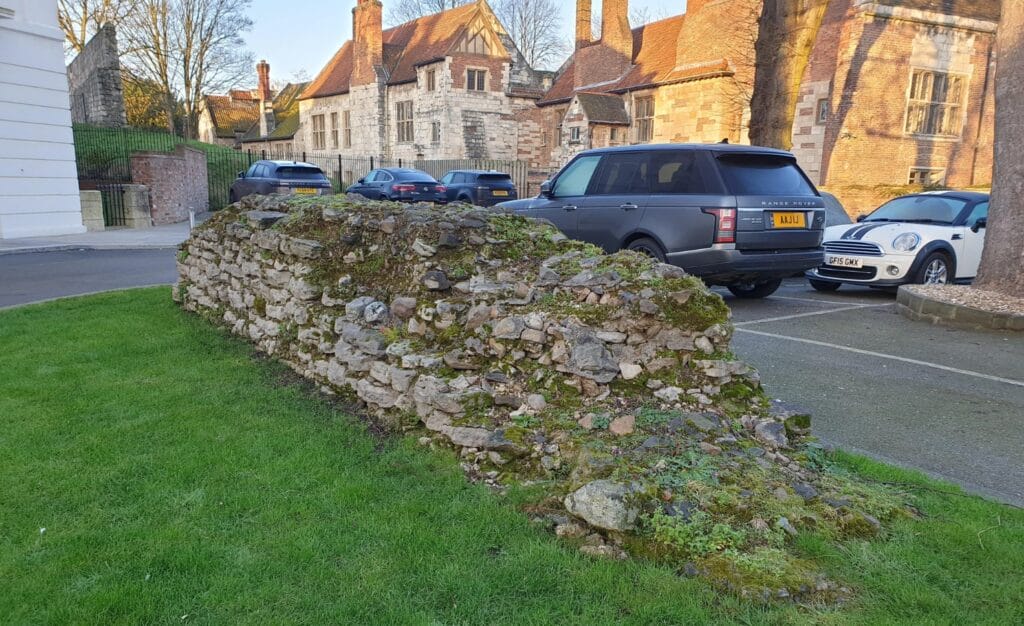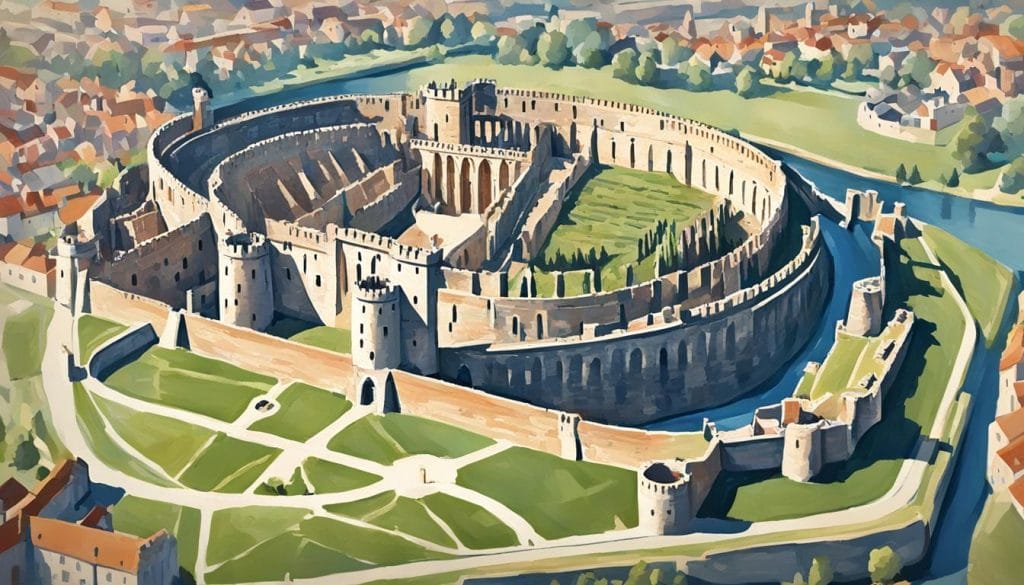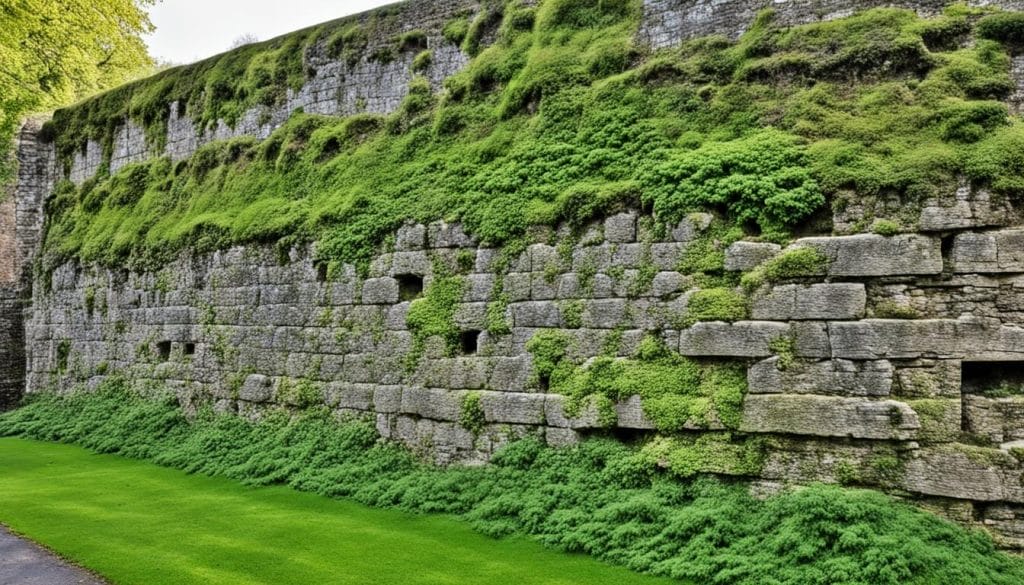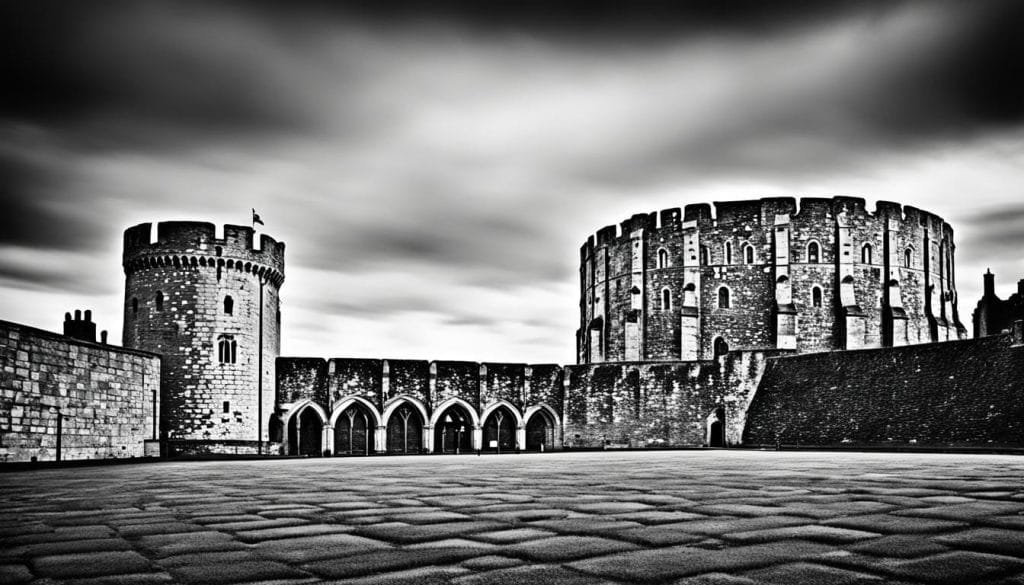Among the myriad of historical landmarks in York, England, none speaks quite as eloquently to the resilience of the past as the ancient Roman fortifications that still stand today. In a city permeated by history, the old York Eboracum Roman fortress wall is a silent witness that has defied the centuries. Erected around 71 AD, this bastion not only marked the boundaries of power but also sheltered countless lives against invasions and revolts in what was once a thriving Roman colony. Today, York is distinguished for preserving more miles of intact ancient walls than any other city in England, inviting modern eyes to gaze upon the skeletal remains of an empire’s vast ambitions.

The endurance of Eboracum’s walls is a testament to Roman engineering, with remnants like the North West Legionary Fortress Wall offering a tactile bridge to an era of conquest and civilization. Stepping along the relics of these structures is an immersive stroll through the annals of time, where one can nearly hear the echoes of centurions and craftsmen who raised these barriers against the unknown.
Key Takeaways
- York’s ancient Roman fortifications are an enduring testament to the city’s historical depth.
- The York Eboracum Roman fortress wall is among the most significant Roman history remnants in England.
- With more miles of ancient walls intact than any other English city, York stands as a prime destination for exploring historical landmarks.
- The North West Legionary Fortress Wall encapsulates the might and engineering skill of the Roman era.
- Visitors to York can experience direct contact with history through these awe-inspiring ancient structures.
A Glimpse into Antiquity: Eboracum’s Lasting Legacy
The stoic remnants of York city walls not only define the landscape of modern York but also narrate tales of the city’s significance as the Roman Empire’s northern frontier. Once the epitome of fortified might and strategic brilliance, these military defense structures shielded Eboracum—a beacon of Roman conquest and ingenuity—against adversarial forces. Through centuries of Viking settlements and Norman rule, the walls continued to assert York’s dominance, morphing into symbols of undying power and prestige.
The Role of York’s Fortress Walls Throughout History
Envisioned as a bulwark against the tumult of the ages, the York fortress walls have undergone numerous transformations. Their origin, as a Roman garrison, laid the groundwork for what would become an adroit combination of military defense and urban glory. The walls, which have seen the footprints of Roman legionaries, Viking warriors, and Norman knights, have been pivotal to the city’s history, serving as a robust defense system and an enduring emblem of power.
What Remains Today of Eboracum’s Fortifications
Today, the legacy left behind by the Roman architects and builders resonates through Eboracum archeological sites peppered across York. The North West Legionary Fortress Wall, with its historic fabric still palpable amidst its stony visage, offers a window into the past, inviting tourists and history enthusiasts alike to explore the vestiges of Roman Britain’s grandeur.
| Fortress Wall Component | Description | Historical Significance |
|---|---|---|
| North West Legionary Fortress Wall | Part of the original fortification erected by Romans | Represents a direct link to York’s Roman past and military heritage |
| Multangular Tower | A ten-sided stone structure within the Museum Gardens | Illustrates transition from Roman to medieval defensive architecture |
| Fortress Gateways (Porta) | The principal entrances to the Roman fortress | Served as control points for the ingress and egress of goods and people |
| Interval Towers | Small defensive towers spaced along the length of the wall | Enhanced surveillance and protection capabilities of the fortification |
While time has eroded the full impressiveness of these structures, the remaining segments of the York city walls beckon as living monuments, standing resolutely as remnants of past glories, enduring through the centuries, portraying the erstwhile might of the Roman Empire at its zenith.
From Rome to the Vikings: York’s Historical Tapestry
York’s journey through time is a prolific narration of conquering legions and questing Vikings. Nestled at the merger of the River Ouse and River Foss, what began as the Roman outpost Eboracum evolved into a topographical manuscript of Northern Europe’s undulating history. Here, the Viking heritage intricately weaves into the city’s fabric, painting a vibrant mosaic of historical eras in York that continue to captivate visitors and historians alike.
Stepping through the thresholds of history, one can experience York’s transformation from a Roman military keystone to a Viking stronghold. The archaeological layers beneath the city’s streets tell tales of power, trade, culture, and daily life. It is within these narratives that York’s top historical attractions stand out—not merely as tourist destinations, but as windows into a dimly-lit world of warriors and empires.

- Eboracum Roman Baths – Unearth the luxuries and social intricacies of a Roman soldier’s life in these well-preserved remnants.
- Jorvik Viking Centre – A vivid re-creation of Viking-age streets invites visitors to a sensory journey into a city under Norse rule.
- Yorkshire Museum – Home to a wealth of artifacts, the museum chronicles York’s dynamic history from its Roman roots to medieval marvels.
- Clifford’s Tower – Ascend to panoramic views of York and ponder over ceaseless cycles of conflict and reclamation.
An immersive encounter with York transcends epochs, each cobblestone chiseled by the craft of Roman masons or tread by Viking boots. To walk amongst these landmarks is to traverse centuries of human ambition and resilience. At every turn, York discloses its stories—a city shaped by the ascent and integration of diverse peoples and traditions over time.
Through the exploration of its rich and storied past, York fuses the intrigue of discovery with the reverence of remembrance, encapsulating within its walls the spirit of civilizations that have long since echoed into legend.
Walking Alongside History: Traversing York’s City Walls
Embarking on a walking tour of York city walls is akin to stepping directly onto the pages of a living history book. As pedestrians journey across the preserved sections, they encounter panoramic views of the city’s historical treasures, one of which is the awe-inspiring York Minster Cathedral. A symbol of the city’s ecclesiastical heritage, the Minster’s spires reach skyward, framing the skyline and offering a glimpse into both the artistic splendor and the celestial aspirations that motivated its medieval builders.
Experiencing York Minster Through the Ages
Within the heart of the city, visiting historic York is elevated by the magnificent presence of York Minster. This grand cathedral, a masterpiece of stained glass and stone, narrates a thousand years of religious devotion and architectural innovation. For those traversing the nearby segments of York’s City Walls, the Minster becomes an anchor point – a constant in the city’s ever-changing landscape.
Connecting with the Past Along the Intact Wall Segments
The City walls’ public access allows visitors to trace the outline of historic York, effectively walking through different eras of the city’s past. From the Romans to the modern day, each step along the solid stone paths of the City Walls invites an intimate connection with those who have walked before us. The fortifications stand today not only as defensive relics but as open-air corridors to the city’s soul.
Eboracum’s Military Might: The York Fortress Structure
The awe-inspiring remnants of Roman military architecture found in York—once the site of a vast legionary fortress—bear testimony to the strategic defense planning and considerable Roman engineering achievements of the time. The layout of the York legionary fortress was a bastion of Roman power and military insight, strikingly evident in its expansive reach and robust construction.

The Strategic Placement of the York Legionary Fortress
Envisioned as a critical military hub, the fortress was cunningly placed to optimize control and defense. Each gate was meticulously positioned to connect to existing roadways and facilitate easy access to surrounding waterways, ensuring swift movement of troops and supplies. This strategic placement reinforces the military acumen that the Romans were revered for.
The Architectural Feats of Eboracum’s Defenders
The fortress’s architectural design was a marvel of Roman engineering, with a sophisticated fortification system transitioning from timber to enduring stone ramparts. The evolution of this defensive system underscores the innovative spirit of Roman architects and engineers, intent on creating an impregnable stronghold.
| Fortress Feature | Strategic Benefit | Engineering Detail |
|---|---|---|
| Oblong Enclosure with Rounded Corners | Reduced blind spots for defenders | Diagonal orientation maximized defensive coverage |
| Strategically Placed Gates | Enabled rapid deployment of forces | Incorporated access to vital roads and rivers |
| Successive Ramparts | Enhanced long-term fortification | Showed the transition from timber to stone construction |
Witnesses of War: Memorials and the Walls They Comprise
Memorial walls serve as silent yet profound storytellers of our military history. They are more than just structures; they are poignant tributes that reflect upon the valor and sacrifices of war heroes. These walls, spanning from historical edifices to modern designs, embody the collective memory of nations and ensure that the tales of those who served are never forgotten.
The Poignant Reflections at the Wall of the Missing
The Wall of the Missing, part of the Cambridge American Cemetery, is a somber expanse honoring over 5,000 soldiers. Each name etched on the wall represents a narrative frozen in time, a life dedicated to the cause of freedom and peace. It’s a reflective space, encouraging visitors to contemplate the enormities of war and the individual acts of bravery that contributed to our collective history.
The Vietnam Veterans Memorial Wall – A Modern Testament
The Vietnam Veterans Memorial Wall in Washington, D.C., emerges as a stark testament to honoring war heroes from a conflicted period in American history. This visually impactful wall lists over 58,000 names, each signifying a valiant soul whose life was altered irreversibly by the Vietnam War. It stands as an architectural embodiment of our nation’s acknowledgment and respect for those who served.
| Memorial | Location | Number of Names | Year Dedicated |
|---|---|---|---|
| Wall of the Missing | Cambridge, England | Over 5,000 | 1956 |
| Vietnam Veterans Memorial Wall | Washington, D.C., USA | Over 58,000 | 1982 |
These memorial walls not only stand as historical markers but also as venues for education and reflection. By visiting such sites, we are prompted to consider the past and comprehend the depths of bravery and sacrifice that are ingrained within our military history. As we reflect upon these monuments, we are reminded of a powerful message: freedom is a gift, one that is fought for and upheld by generations of courageous individuals.
Remembering the Fallen: Tributes Etched in Stone
The ancient stones of York, once the beating heart of the Roman Empire’s northern presence, serve as more than just historical artifacts. They are a silent homage to those who once defended the empire’s distant borders. Here, in the city once known as Eboracum, meticulous engraved commemorations immortalize the enduring spirit of the fallen soldiers, their names etched into the very essence of this historic city.
These commemorative inscriptions offer a profound Roman fortress remembrance, providing us with the rare opportunity to connect with individual stories from a distant past. Among these tributes, York’s Fortress Wall remnant stands out, its enduring presence a testament to the men who once guarded this outpost of empire and civilization.
For visitors and history enthusiasts alike, each etching is a tangible Eboracum tribute to fallen soldiers, and a solemn reminder of the universality of sacrifice throughout the annals of human history. The significance of these historical tributes can’t be understated, as they continue to bridge the gap between ancient legacies and modern remembrance practices.
As the sun sets on the robust stones of York, casting long shadows across the inscriptions that detail bravery and valor, one can’t help but feel a deep connection to the legacy of Roman might and, even more poignantly, a sense of gratitude to those who laid down their lives in distant lands. It is our duty to honor these messages from the past, ensuring that the enlightened honor and respect continues for generations to come.
A Fragment of the North West Legionary Fortress Wall in York eboracum
Amidst the modern city of York stands a monument of ancient history: a segment of the North West Legionary Fortress Wall – a testament to Eboracum’s former glory. Recent archeological excavations have unveiled this robust barricade, offering a rare glimpse of military prowess that anchored the far reaches of the Roman Empire.
The Archaeological Revelations of the Fortress Wall
The discovery of the Eboracum fortress remains not only captivates historians but also ignites the imagination of visitors, as each stone unearthed weaves itself into the grand narrative of York’s past. With scrupulous archeological excavation, each layer examined affirms the fortress’s strategic importance and resilience throughout centuries.

As the earth surrendered its secrets, the archeological teams elucidated details of the fortress’s construction. Their findings showcased a blend of utility and marvel, proving just how advanced Roman engineering was at the time.
Understanding York’s Roman Roots Through Preservation
Resounding efforts in Roman heritage conservation illustrate a commitment to preserving York’s fortress walls, an initiative that cements the city’s dedication to its rich historical fabric. These preservation acts not only honor ancient craftsmanship but also ensure that the echoes of Roman culture remain an integral part of York’s identity.
- Assessment of structural integrity
- Restorative procedures to safeguard the relic
- Public education projects to inform and inspire
This section of wall invites onlookers to touch the very stones that soldiers might have leaned upon centuries ago. In preserving these relics, York enables its citizens and visitors to appreciate the city’s beginnings, laying a foundation of understanding for the Roman contributions to modern society.
Juxtaposition of Eras: The Medieval and Roman Symbiosis in York
The storied city of York presents a unique historical landscape where the narratives of Roman and medieval times are intricately interwoven. This remarkable blend of periods can be found etched in the very architecture and ruins that populate the city, making it a haven for those who seek to immerse themselves in the depths of Britain’s past. At the heart of this symbiosis lies the imposing structure of Clifford’s Tower and the serene vestiges of what was once the illustrious St. Mary’s Abbey.
Clifford’s Tower: A Sombre Reminder Amidst York’s Charming Vistas
Perched atop its mound, Clifford’s Tower serves as a stark monument within the bustling urban life of medieval York. It is a sombre memorial to the city’s darker history, particularly the grievous events that befell the Jewish community in 1190. The tower, with its foreboding yet captivating presence, offers a window into the city’s turbulent past and the layers of history that have shaped York’s complex character.

York’s St. Mary’s Abbey: The Monastic Ruins Near the Roman Walls
Nestled amidst the verdant gardens of the Museum Gardens, the ruins of St. Mary’s Abbey echo the monastic life that once thrived beside the remnants of Rome’s boundary in York. Here, ancient stones tell tales of ecclesiastical splendour and monastic routines, offering an evocative contrast to the stark militarism of the nearby Roman fortifications. The proximity of these medieval ruins to the Roman walls accentuates the seamless Roman and medieval symbiosis that is a cornerstone of York’s historical landscape.
The enduring allure of these sites not only resides in their majestic beauty but also in the stories they preserve—stories of conquest, faith, tragedy, and resilience. Visitors strolling through these historic locations experience the dual essence of York’s bygone epochs, a testament to the city’s capacity to captivate and enlighten across the centuries.
Conclusion
As we bring our journey through the annals of York to a close, we’re reminded that the fabric of this city is woven with stories that reach back through the ages. The commitment to York historical preservation has allowed structures like the North West Legionary Fortress Wall to stand not merely as relics of the past, but as living classrooms, providing historical significance education to all who wander their ancient paths.
Preserving York’s Heritage for Future Generations
The efforts to maintain and protect York’s legacy are paramount in ensuring that the spirit of Eboracum and its extensive narrative continue to resonate with upcoming generations. Through considered conservation, we are afforded the opportunity to gaze upon the same stonework that has witnessed the march of centuries, safeguarding such treasures for those yet to come.
How Visiting the Eboracum Fortress Wall Influences Our Perception of History
Visitors to York are often deeply moved by the Eboracum fortress wall tourism impact, as walking alongside these ancient defenses brings an acute awareness to the layers of history beneath our feet. It is this tangible connection to the human endeavors of our ancestors that truly enhances our understanding of the past, altering our perception and deepening our respect for the groundwork it laid for our present-day society.
FAQ
What is the historical significance of York’s Eboracum Roman fortress wall?
The York Eboracum Roman fortress wall is a significant historical landmark that exemplifies the presence and power of the Roman Empire in northern England. Constructed as ancient Roman fortifications, these walls served as vital military defense structures and stand today as a testament to Roman engineering and military might.
How have York’s fortress walls evolved through different historical eras?
York’s fortress walls have played a central role throughout varying historical periods, transforming from a protective Roman garrison to a Viking stronghold and later, a significant component of Norman defense strategies. Each era has left its mark, contributing to the rich historical tapestry of the city.
What parts of Eboracum’s fortifications are still visible in York today?
Visitors can explore segments of the original fortifications, including the North West Legionary Fortress Wall, a key archeological site. These remnants offer a direct link to the city’s past as part of the Roman Empire’s northern frontier and act as a focal point for Roman history enthusiasts visiting York.
What experiences are offered by walking tours along York city walls?
Walking tours along York city walls provide an opportunity to experience historic York intimately. These tours offer impressive views of major landmarks such as the York Minster Cathedral and invite participants to connect with diverse historical eras through public access to well-preserved wall segments.
How was the York legionary fortress strategically placed and constructed?
The York legionary fortress was strategically placed to control major roads and waterways, leveraging its formidable position for trade and military advantage. The fortress’s layout and construction reflect the advanced Roman military architecture and engineering achievements of the time.
What can we learn from memorial walls such as the Wall of the Missing or the Vietnam Veterans Memorial Wall?
Memorial walls like the Wall of the Missing and the Vietnam Veterans Memorial Wall offer poignant reflections on military history, honoring war heroes and the human cost of conflict. These memorials serve as powerful tributes and ensure that the sacrifices of the fallen are not forgotten.
Why are historical tributes like those found in Eboracum important?
Historical tributes in Eboracum, such as inscribed commemorations, serve to remember and honor the fallen soldiers from past conflicts. They symbolize the remembrance of dedication and sacrifice, providing a tangible link to York’s rich military history and the individuals who shaped it.
How does the preservation of the North West Legionary Fortress Wall contribute to our understanding of Roman York?
The preservation of the North West Legionary Fortress Wall is pivotal to understanding York’s Roman roots. Archeological excavation and conservation efforts at this Eboracum fortress remains discovery provide valuable insights into the robustness, scale, and engineering sophistication of Roman fortifications.
What is the significance of medieval structures like Clifford’s Tower and St. Mary’s Abbey in York?
Clifford’s Tower and St. Mary’s Abbey are medieval structures that, alongside Roman walls, tell a story of the convergence of two significant periods in York’s history. They provide a contrasting yet harmonistic landscape that enriches the cultural and historical narrative of the city.
How does visiting York’s Eboracum Fortress Wall enhance our perception of history?
Visiting the Eboracum Fortress Wall allows individuals to immerse themselves in the city’s long-standing history, providing a physical connection to the past. It deepens our perception of historical significance and educates visitors on the continuous impact of historical developments on today’s world.
Source Links
- https://inspiredbylifeandfiction.com/if-these-walls-could-talk/
- https://momentmag.com/york-jews/
- https://www.british-history.ac.uk/rchme/york/vol1/pp5-47
